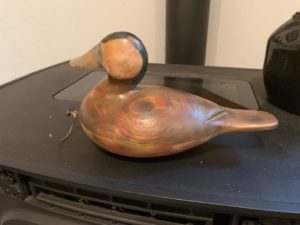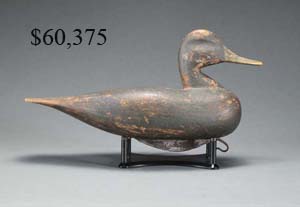A Decoy Corner Article
By Bruce Urben, WWA President

Author Bruce Urben carved this contemporary antique Dudley ruddy duck
The east coast had some of the most highly regarded carvers in the nation back in the early 1900’s. It is time to look at one carver (and his brother, forming their carving team) that fits that title.
Delon Lee Dudley and his twin brother, Lem, were born in January, 1861, three months before the bloodiest war in this Nations history, the Civil War! They were born and raised on Knotts Island, North Carolina, and lived there for their entire lives. Knotts Island is just south of Virginia Beach on Currituck Sound, adjacent to the Atlantic Ocean.
Lee and Lem were market hunters, trappers and most of their work and pleasure centered on the open waters and marshy borders surrounding their home. The twin brothers began carving decoys later in life in 1892. According to family records, Lee carved substantially more decoys than Lem but it is impossible to differentiate their work. Almost all of the decoys carved by the brothers were done between 1892 and 1900, so if you find an original Dudley decoy you are assured it is well over 120 years old!

A Lee Dudley greenwing teal showing the LD carved in the bottom of his decoys
We are told that Lee carved hundreds of decoys in his lifetime, most for their own use, but it is known both brothers carved for a neighbor family (the Ballance’s) with whom they hunted. All decoys from their personal rig were branded “LD” on the bottom. History tells us that they also carved decoys for several area duck clubs including, the Dudley Island Club, Pocahontas, Pellitory Gun Club, Back Bay and NorthEnd Clubs. By that time their full time job was carving working decoys!
Their decoys all suffered very hard usage and there are few examples found with much original paint.

A Lee Dudley widgeon hen
Lee Dudley decoys resemble Susquehanna Flats decoys, except most have some semblance of wing carving near the back tail. His decoys are characterized and distinguished by their smooth humped backs, painted eyes (or, in many cases, no eyes) and stylish, high crowned heads. They had a bold singular form, sweeping powerful chest with smooth curved lines, compact bodies and as previously mentioned, relief carved wings near the back. It is known that they carved canvasback, redhead, scaup, geese, widgeon, teal, several pintails and ruddy duck species. Lee is best known for his ruddy duck decoys! He used square, cut nails to hold his anchor weights or leather ties.
In the 1900’s, Dudley decoys could be bought for five cents each. By 1965, the value had risen some 1,000%. In 1913, the whole Dudley personal rig (hundreds of decoys) were sold to a Knotts’s Island Club for 50 cents apiece!
Adele Earnest in her book “The Art of The Decoy” (1965) characterizes Lee’s decoys as the best of their kind, his heads are pure sculpture!

This Lee Dudley black duck sold in a 2009 auction for over $60,000
Unfortunately, there are very few Dudley decoys on the market, and when there are, they command premium prices by collectors. Several editions of the Decoy Price Guide reports auction sales of $8,000-$20,000 for a Dudley decoy. Dudley decoys continue to be in the top 50 decoys sold at auction at high value to this day. Warman’s Decoy Price Guide (2006) lists Dudley decoys in the $2,000-$10,000 range, regardless of condition.
Lem Dudley passed away in 1930 and Lee passed in 1942 at the age of 81.
Although Delon Lee Dudley was small in stature, he was very large in decoy carving history. The most famous North Carolina decoy carver!
